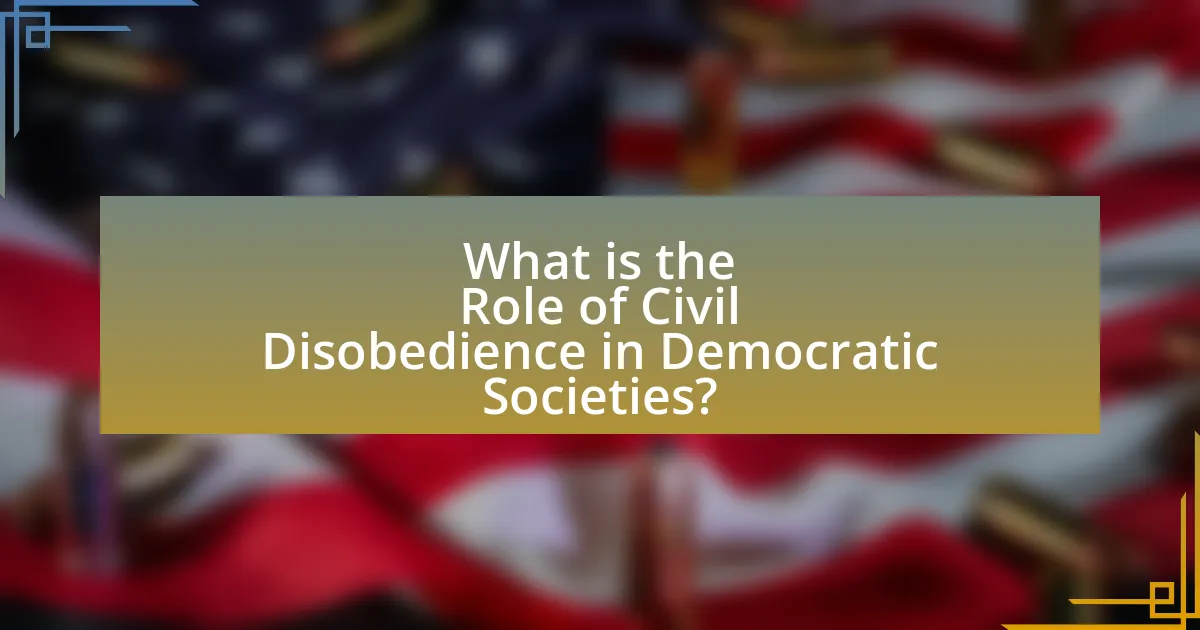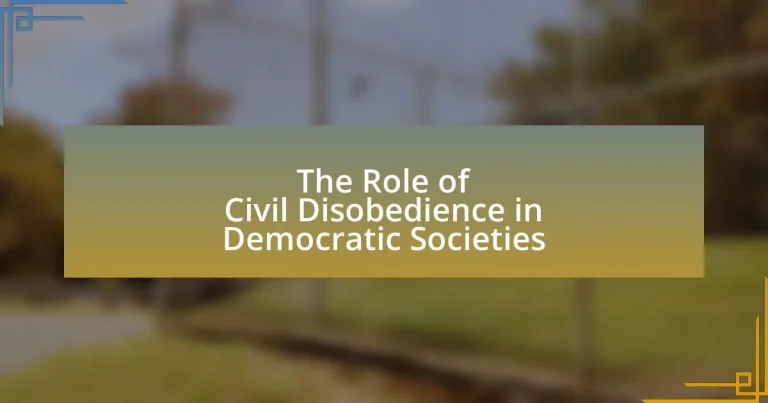Civil disobedience is a fundamental aspect of democratic societies, enabling citizens to challenge unjust laws and advocate for social change through nonviolent resistance. This article explores the definition of civil disobedience, its historical significance, and its role in shaping public policy and governance. Key examples, such as the Civil Rights Movement and the anti-apartheid struggle, illustrate how civil disobedience has led to significant legislative reforms and societal shifts. The article also examines the ethical implications, potential consequences, and best practices for engaging in civil disobedience, emphasizing its importance in upholding democratic principles and fostering public discourse.

What is the Role of Civil Disobedience in Democratic Societies?
Civil disobedience plays a crucial role in democratic societies by allowing citizens to challenge unjust laws and policies through nonviolent resistance. This form of protest serves as a mechanism for social change, enabling marginalized voices to be heard and prompting governmental accountability. Historical examples, such as the Civil Rights Movement in the United States, illustrate how civil disobedience can lead to significant legislative reforms, such as the Civil Rights Act of 1964, which aimed to eliminate racial discrimination. By engaging in civil disobedience, individuals assert their moral beliefs and encourage public discourse, ultimately strengthening the democratic process.
How is civil disobedience defined within the context of democracy?
Civil disobedience is defined within the context of democracy as the intentional and public violation of laws or regulations to challenge perceived injustices and advocate for social change. This form of protest is rooted in the belief that individuals have a moral obligation to oppose unjust laws, as exemplified by historical figures like Martin Luther King Jr., who argued that “one has a moral responsibility to disobey unjust laws.” In democratic societies, civil disobedience serves as a mechanism for citizens to express dissent and influence policy, reinforcing the idea that democracy thrives on active participation and the contestation of authority.
What historical examples illustrate civil disobedience in democratic societies?
Historical examples of civil disobedience in democratic societies include the American Civil Rights Movement, particularly the actions led by Martin Luther King Jr., who advocated for nonviolent resistance against racial segregation and discrimination. Another significant example is the anti-apartheid movement in South Africa, where figures like Nelson Mandela and Desmond Tutu engaged in civil disobedience to challenge the oppressive apartheid regime. Additionally, the Women’s Suffrage Movement in the early 20th century, where activists like Susan B. Anthony and Emmeline Pankhurst employed civil disobedience to secure voting rights for women, further illustrates this phenomenon. These instances demonstrate how civil disobedience has been a crucial tool for marginalized groups to effect change within democratic frameworks.
How does civil disobedience differ from other forms of protest?
Civil disobedience differs from other forms of protest primarily in its intentional violation of laws to challenge unjust policies or practices. Unlike conventional protests that may operate within legal boundaries, civil disobedience is characterized by the deliberate and nonviolent breaking of laws to highlight moral or ethical issues, as exemplified by figures like Martin Luther King Jr. during the Civil Rights Movement. This approach aims to provoke change by drawing public attention to perceived injustices, often leading to legal consequences for the participants, which further emphasizes the seriousness of their cause. Historical instances, such as the Salt March led by Mahatma Gandhi, illustrate how civil disobedience can effectively mobilize public opinion and challenge oppressive systems, setting it apart from other protest methods that may not involve lawbreaking.
Why is civil disobedience considered a vital component of democracy?
Civil disobedience is considered a vital component of democracy because it serves as a mechanism for citizens to challenge unjust laws and government actions. This form of protest allows individuals to express dissent and advocate for social change when traditional political processes fail to address grievances. Historical examples, such as the Civil Rights Movement in the United States, demonstrate how civil disobedience can lead to significant legislative reforms, such as the Civil Rights Act of 1964, which aimed to eliminate racial discrimination. By engaging in nonviolent resistance, citizens uphold democratic principles by holding authorities accountable and fostering public discourse on moral and ethical issues.
What principles of democracy are upheld through civil disobedience?
Civil disobedience upholds the principles of justice, equality, and the rule of law within democratic societies. By challenging unjust laws or policies, civil disobedience emphasizes the moral obligation to act against oppression, thereby reinforcing the principle of justice. Historical examples, such as the Civil Rights Movement in the United States, illustrate how individuals like Martin Luther King Jr. engaged in nonviolent protests to demand equal rights, highlighting the importance of equality in a democracy. Furthermore, civil disobedience often operates within the framework of the rule of law, as it seeks to bring attention to legal injustices while advocating for change through lawful means, such as peaceful protests and public discourse.
How does civil disobedience contribute to social change?
Civil disobedience contributes to social change by challenging unjust laws and practices, thereby raising public awareness and prompting legislative reform. Historical examples include the Civil Rights Movement in the United States, where acts of civil disobedience, such as sit-ins and marches, highlighted racial injustices and led to significant legal changes, including the Civil Rights Act of 1964. This demonstrates that civil disobedience can mobilize public opinion and pressure governments to address social inequalities, ultimately fostering a more just society.
What are the ethical implications of civil disobedience in democratic societies?
The ethical implications of civil disobedience in democratic societies include the justification of breaking laws to challenge unjust policies and the potential for undermining the rule of law. Civil disobedience is often viewed as a moral obligation when legal avenues fail to address systemic injustices, as seen in historical movements like the Civil Rights Movement in the United States, where activists like Martin Luther King Jr. argued that unjust laws must be disobeyed to promote social change. However, this practice raises concerns about the balance between individual conscience and societal order, as widespread disobedience can lead to chaos and challenge the legitimacy of democratic institutions. The ethical debate centers on whether the ends justify the means, particularly when the actions taken may disrupt public order or infringe on the rights of others.
How do proponents justify civil disobedience as a moral action?
Proponents justify civil disobedience as a moral action by asserting that it is a necessary response to unjust laws and government actions. They argue that when legal channels fail to address systemic injustices, individuals have a moral obligation to resist through nonviolent means. Historical examples, such as Martin Luther King Jr.’s advocacy for civil rights, illustrate this justification; King emphasized that “one has a moral responsibility to disobey unjust laws.” This perspective is supported by the belief that civil disobedience can raise awareness and prompt social change, as seen in the abolition of slavery and the civil rights movement, where acts of disobedience highlighted the moral failings of the status quo.
What are the counterarguments against civil disobedience?
Counterarguments against civil disobedience include the potential for undermining the rule of law, the risk of escalating violence, and the possibility of creating social division. Critics argue that civil disobedience can erode respect for legal institutions, as it encourages individuals to selectively obey laws based on personal beliefs, which may lead to chaos and disorder. Historical examples, such as the violent backlash against protests during the civil rights movement, illustrate how civil disobedience can provoke aggressive responses from authorities, potentially resulting in harm to both protesters and bystanders. Additionally, opponents contend that civil disobedience can polarize communities, as it may alienate those who view such actions as disruptive rather than constructive, thereby hindering dialogue and compromise.
How does civil disobedience impact public policy and governance?
Civil disobedience significantly impacts public policy and governance by challenging unjust laws and prompting governmental reform. Historical examples, such as the Civil Rights Movement in the United States, illustrate how acts of civil disobedience, like the Montgomery Bus Boycott, led to the dismantling of segregation laws and the enactment of the Civil Rights Act of 1964. This demonstrates that when citizens engage in nonviolent resistance, it can raise awareness, mobilize public opinion, and ultimately influence legislative change. Additionally, civil disobedience can create pressure on policymakers to address social injustices, as seen in the anti-apartheid movement in South Africa, which contributed to the end of apartheid and the establishment of a democratic government.
What role does civil disobedience play in shaping legislation?
Civil disobedience plays a crucial role in shaping legislation by highlighting social injustices and prompting legislative change. Historical examples, such as the Civil Rights Movement in the United States, demonstrate how acts of civil disobedience, like the Montgomery Bus Boycott and sit-ins, pressured lawmakers to enact significant legislation, including the Civil Rights Act of 1964. These actions mobilized public opinion and drew attention to systemic inequalities, ultimately leading to legal reforms that addressed civil rights issues. Thus, civil disobedience serves as a catalyst for legislative action by raising awareness and demanding accountability from governing bodies.
How do governments typically respond to acts of civil disobedience?
Governments typically respond to acts of civil disobedience through a combination of legal action, public discourse, and sometimes repression. Legal action often involves arresting participants, enforcing fines, or pursuing charges against individuals involved in the disobedience, as seen in historical instances like the civil rights movement in the United States, where activists faced arrest for protests. Public discourse may include government officials addressing the issues raised by the disobedience, which can lead to policy discussions or reforms, as evidenced by the responses to the anti-apartheid movement in South Africa. In some cases, governments may resort to repression, employing law enforcement to disperse protests or maintain order, as observed during the Tiananmen Square protests in China. These varied responses reflect the complexities of balancing law, order, and the rights of citizens to express dissent in democratic societies.
What are the potential consequences of civil disobedience for individuals and society?
Civil disobedience can lead to legal repercussions for individuals, such as arrest or fines, while also prompting societal change by raising awareness of injustices. Individuals engaging in civil disobedience often face criminal charges, as seen in historical examples like the civil rights movement, where activists were arrested for protesting segregation laws. This legal consequence can deter some from participating, yet it can also galvanize public support and lead to significant societal shifts, as demonstrated by the eventual repeal of discriminatory laws following widespread protests. Thus, civil disobedience serves as a catalyst for dialogue and reform, impacting both the individuals involved and the broader society.
What legal repercussions can participants in civil disobedience face?
Participants in civil disobedience can face various legal repercussions, including arrest, fines, and imprisonment. These consequences arise because civil disobedience often involves the intentional violation of laws deemed unjust, leading to legal actions by authorities. For instance, historical examples such as the civil rights movement in the United States demonstrate that activists faced arrest and jail time for protests against segregation laws. Additionally, legal penalties can vary based on the jurisdiction and the nature of the act of disobedience, with some participants facing misdemeanor charges while others may encounter felony charges depending on the severity of their actions.
How can civil disobedience lead to societal division or unity?
Civil disobedience can lead to societal division or unity depending on the context and the responses it elicits from various groups. When individuals or groups engage in civil disobedience to challenge unjust laws, it can unify supporters who share similar values and goals, as seen in the Civil Rights Movement, where acts of nonviolent protest galvanized widespread support for racial equality. Conversely, civil disobedience can also create division, particularly when it provokes backlash from opposing factions or authorities, as evidenced by the protests against the Vietnam War, which polarized public opinion and led to significant societal rifts. Thus, the impact of civil disobedience on society hinges on the prevailing social climate and the reactions it provokes.
How can citizens effectively engage in civil disobedience within a democratic framework?
Citizens can effectively engage in civil disobedience within a democratic framework by organizing nonviolent protests, clearly articulating their grievances, and adhering to legal boundaries to maintain legitimacy. Nonviolent protests, such as marches or sit-ins, have historically proven effective, as seen in the Civil Rights Movement, where figures like Martin Luther King Jr. emphasized peaceful resistance to unjust laws. Articulating grievances ensures that the public and authorities understand the reasons behind the disobedience, fostering dialogue and potential reform. Additionally, adhering to legal boundaries, such as notifying authorities of planned protests, can help maintain public support and avoid backlash, as demonstrated by successful movements in various democratic societies.
What strategies can individuals use to ensure their actions are impactful?
Individuals can ensure their actions are impactful by clearly defining their goals, engaging in strategic planning, and fostering community collaboration. Clearly defined goals provide direction and measurable outcomes, which enhance the effectiveness of actions. Strategic planning involves assessing the political landscape, identifying key stakeholders, and determining the most effective methods of engagement, such as peaceful protests or advocacy campaigns. Community collaboration amplifies individual efforts, as collective action often leads to greater visibility and influence. For instance, historical movements like the Civil Rights Movement in the United States demonstrated that coordinated efforts among diverse groups can lead to significant societal change, evidenced by the passing of the Civil Rights Act of 1964.
What best practices should be followed to maintain nonviolence in civil disobedience?
To maintain nonviolence in civil disobedience, participants should adhere to clear communication, strategic planning, and a commitment to peaceful methods. Clear communication ensures that all participants understand the goals and methods of the action, which helps prevent misunderstandings that could lead to violence. Strategic planning involves organizing actions in a way that minimizes the risk of confrontation with authorities, such as choosing locations and times that reduce the likelihood of escalation. A commitment to peaceful methods includes training participants in nonviolent resistance techniques, emphasizing the importance of remaining calm and composed in the face of provocation. Historical examples, such as the Civil Rights Movement led by Martin Luther King Jr., demonstrate that these practices effectively fostered nonviolent resistance and garnered public support.


